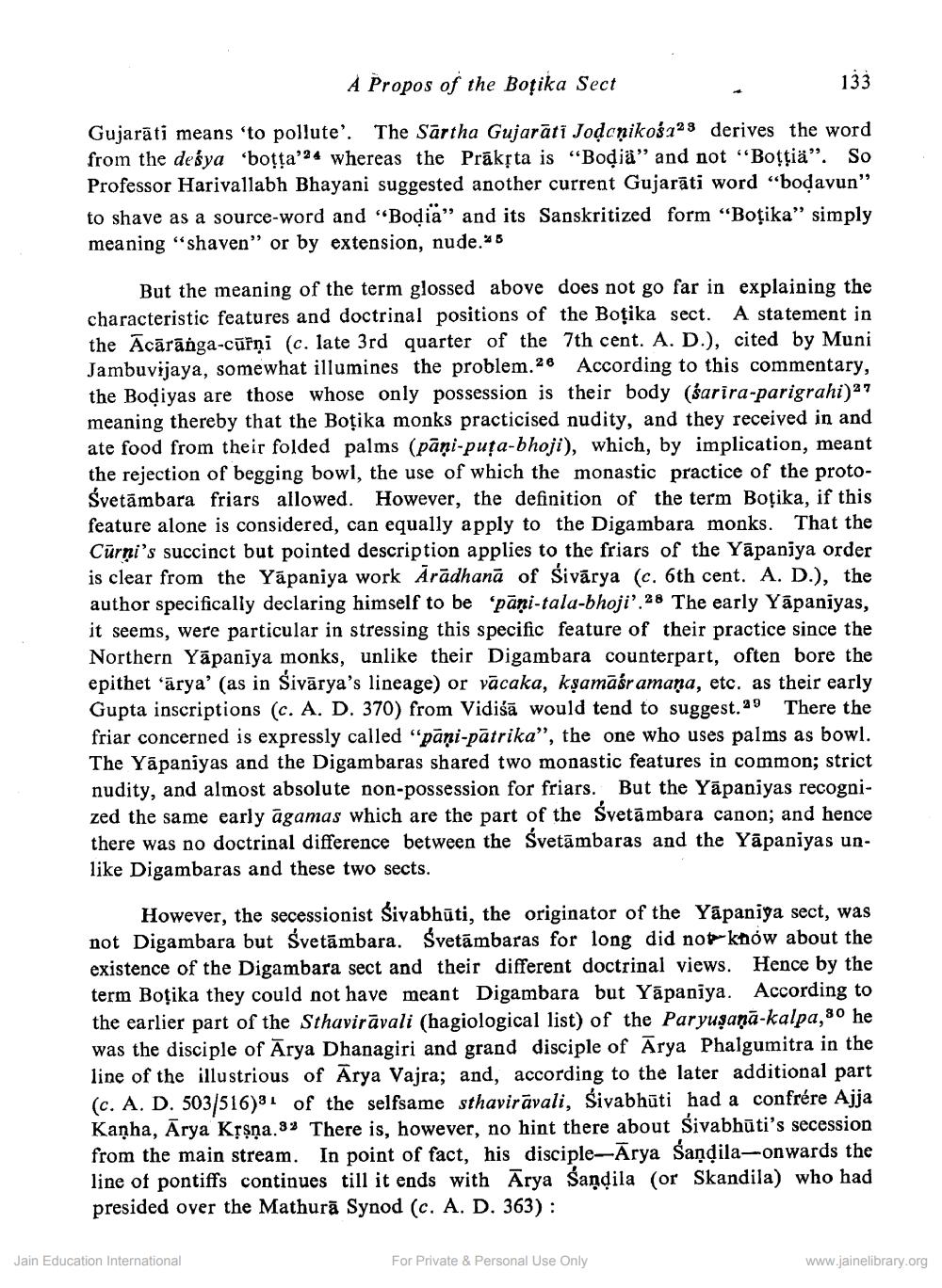________________
A Propos of the Boţika Sect
133
Gujarati means 'to pollute'. The Sārtha Gujarāti Jodonikosa28 derives the word from the desya 'bota 24 whereas the Prāksta is “Bodia" and not "Boyțiä”. So Professor Harivallabh Bhayani suggested another current Gujarāti word “boļavun" to shave as a source-word and "Bodia" and its Sanskritized form "Boţika" simply meaning "shaven” or by extension, nude. 26
But the meaning of the term glossed above does not go far in explaining the characteristic features and doctrinal positions of the Boţika sect. A statement in the Ācārānga-cūrņi (c. late 3rd quarter of the 7th cent. A. D.), cited by Muni Jambuvijaya, somewhat illumines the problem. 26 According to this commentary, the Bodiyas are those whose only possession is their body (šarira-parigrahi)27 meaning thereby that the Boţika monks practicised nudity, and they received in and ate food from their folded palms (pāņi-puța-bhoji), which, by implication, meant the rejection of begging bowl, the use of which the monastic practice of the protoSvetāmbara friars allowed. However, the definition of the term Botika, if this feature alone is considered, can equally apply to the Digambara monks. That the Cūrni's succinct but pointed description applies to the friars of the Yāpaniya order is clear from the Yāpaniya work Ārādhanā of Sivārya (c. 6th cent. A. D.), the author specifically declaring himself to be 'pāņi-tala-bhoji'.28 The early Yāpaniyas, it seems, were particular in stressing this specific feature of their practice since the Northern Yāpaniya monks, unlike their Digambara counterpart, often bore the epithet 'ärya' (as in Sivārya's lineage) or vācaka, kşamāśramana, etc. as their early Gupta inscriptions (c. A. D. 370) from Vidiśā would tend to suggest. 29 There the friar concerned is expressly called "pani-pātrika”, the one who uses palms as bowl. The Yāpaniyas and the Digambaras shared two monastic features in common; strict nudity, and almost absolute non-possession for friars. But the Yāpaniyas recognized the same early āgamas which are the part of the Svetāmbara canon; and hence there was no doctrinal difference between the Svetāmbaras and the Yāpaniyas unlike Digambaras and these two sects.
However, the secessionist Sivabhūti, the originator of the Yapaniya sect, was not Digambara but Svetāmbara. Svetāmbaras for long did not know about the existence of the Digambara sect and their different doctrinal views. Hence by the term Boţika they could not have meant Digambara but Yāpaniya. According to the earlier part of the Sthavirāvali (hagiological list) of the Paryuşaņā-kalpa, 30 he was the disciple of Ārya Dhanagiri and grand disciple of Arya Phalgumitra in the line of the illustrious of Arya Vajra; and, according to the later additional part (c. A. D. 503/516)81 of the selfsame sthavirāvali, Sivabhūti had a confrére Ajja Kanha, Ārya Kļşņa.3% There is, however, no hint there about Sivabhūti's secession from the main stream. In point of fact, his disciple-Arya Saņdila-onwards the line of pontiffs continues till it ends with Ārya Sandila (or Skandila) who had presided over the Mathurā Synod (c. A. D. 363) :
Jain Education International
For Private & Personal Use Only
www.jainelibrary.org




